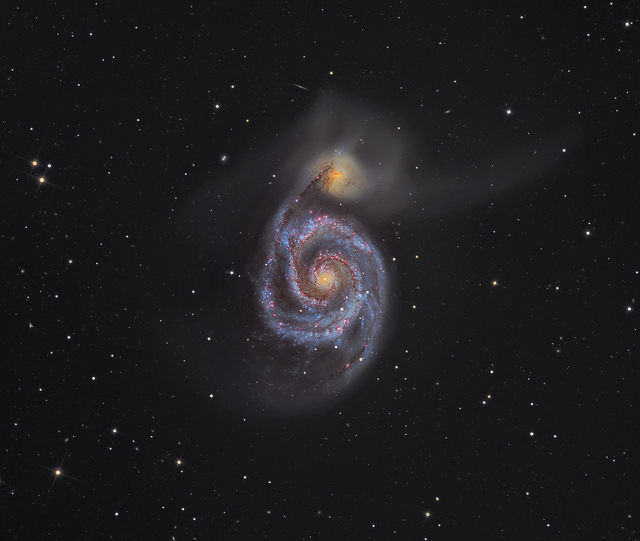

The overall winner in the Royal Observatory Greenwich’s annual Astronomy Photographer of the Year competition, M51 by Martin Pugh.
Want to see some absolutely gorgeous images of our Universe, all taken by amateur astrophotographers? Look no farther than the winners of the 4th annual Astronomy Photographer of the Year competition, held by the Royal Observatory Greenwich and Sky at Night Magazine. The winners were announced last night at the Royal Observatory, with a record number of entries received in 2012 from photographers from around the world.
“Many of the pictures have been taken with equipment that was out of the range of the amateur many years ago,” said Sir Patrick Moore, from the BBC’s Sky at Night, who is a judge in the competition. “I also like the choice of subjects: photographing people and the night skies is very difficult. The entrants have done very well indeed.”
The overall winner was from Australian Martin Pugh with his beautiful and crisp shot of M51, the Whirlpool Galaxy.
“The photographer has made the most of exceptionally good atmospheric conditions to capture an astonishing range of detail in his image of this iconic galaxy,” said Dr. Marek Kukula, the Royal Observatory Public Astronomer and a judge in the competition. “The beautiful spiral structure, dark lanes of dust, and the way the pink clouds of hydrogen really stand out – it’s a remarkable achievement by an amateur astronomer; one of the best images of M51 that I’ve seen.”
Here are more of the winning shots (and you can click on any of these images for the larger versions on Flickr or the ROG site):
The “People and Space” winner was Laurent Laveder from France, with “Facing Venus-Jupiter Close Conjunction.”
The “Our Solar System” category winner was Transit of Venus 2012 in Hydrogen-Alpha, by Chris Warren of the UK.
One of the year’s biggest astronomical events, the last transit of Venus for 105 years, was featured in numerous entries to the 2012 competition. The Our Solar System category was won by Chris Warren, for his fleeting image of the transit taken through a thin patch of cloud at Blackheath in London. F
Earth and Space category winner, “Orion, Taurus and the Pleiades” by Masahiro Miyasaka from Japan.
The winner of the Earth and Space category was Japan’s Masahiro Miyasaka for his image of Orion, Taurus and the Pleiades forming a dramatic backdrop above an eerie frozen landscape in Nagano.
“Young Astronomy Photographer of the Year” category winner was Jacob von Chorus from Canada
Young Astronomy Photographer of the Year accolade was won by 15 year old Jacob von Chorus from Canada, who impressed the judges with his beautiful shot of the Pleiades, showing many of the hot young stars which make up the cluster and the swirling wisps of blue-hued gas.
See more images of the winning and runner-up “Highly Commended” for each category at the ROG’s website.
See here for information about how you can participate in next year’s competition. Congrats to this year’s winners!
How can we explore Saturn’s moon, Enceladus, to include its surface and subsurface ocean, with…
Have you ever wondered how astronomers manage to map out the Milky Way when it's…
NASA astronomers have been continuing to monitor the trajectory of asteroid 2024 YR4. The initial…
Some exoplanets have characteristics totally alien to our Solar System. Hot Jupiters are one such…
Stars form in Giant Molecular Clouds (GMCs), vast clouds of mostly hydrogen that can span…
Let’s dive into one of those cosmic curiosities that's bound to blow your mind: how…